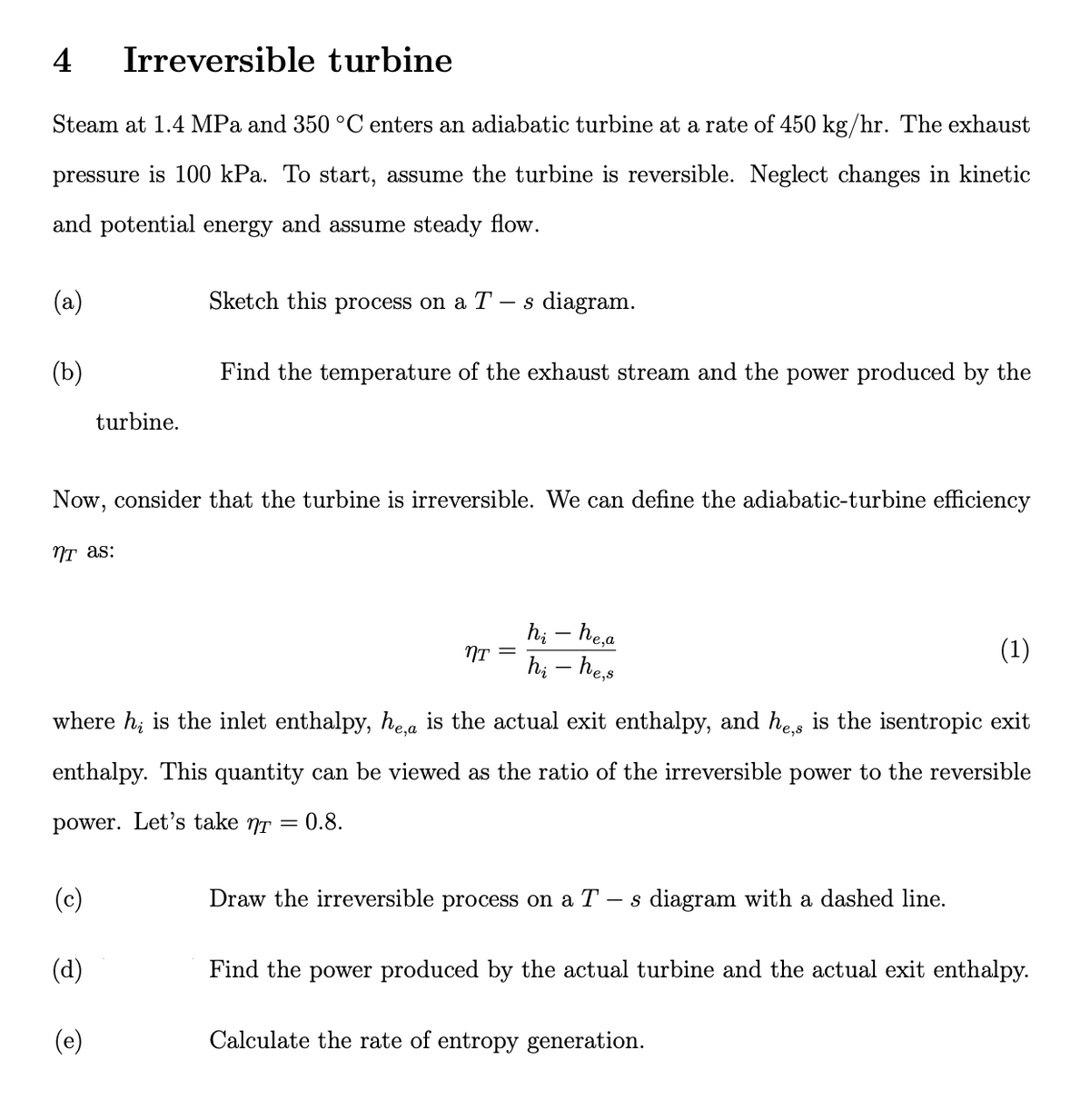Steam at 1.4 MPa and 350 °C enters an adiabatic turbine at a rate of 450 kg/hr. The exhaust pressure is 100 kPa. To start, assume the turbine is reversible. Neglect changes in kinetic and potential energy and assume steady flow. (a) Sketch this process on a T- s diagram.
Steam at 1.4 MPa and 350 °C enters an adiabatic turbine at a rate of 450 kg/hr. The exhaust pressure is 100 kPa. To start, assume the turbine is reversible. Neglect changes in kinetic and potential energy and assume steady flow. (a) Sketch this process on a T- s diagram.
Elements Of Electromagnetics
7th Edition
ISBN:9780190698614
Author:Sadiku, Matthew N. O.
Publisher:Sadiku, Matthew N. O.
ChapterMA: Math Assessment
Section: Chapter Questions
Problem 1.1MA
Related questions
Question

Transcribed Image Text:4
Irreversible turbine
Steam at 1.4 MPa and 350 °C enters an adiabatic turbine at a rate of 450 kg/hr. The exhaust
pressure is 100 kPa. To start, assume the turbine is reversible. Neglect changes in kinetic
and potential energy and assume steady flow.
Sketch this process on a T - s diagram.
(a)
(b)
turbine.
Now, consider that the turbine is irreversible. We can define the adiabatic-turbine efficiency
nT as:
Find the temperature of the exhaust stream and the power produced by the
(c)
(d)
(e)
(1)
where h, is the inlet enthalpy, he,a is the actual exit enthalpy, and he,s is the isentropic exit
enthalpy. This quantity can be viewed as the ratio of the irreversible power to the reversible
power. Let's take n
0.8.
=
hi - he,a
hi - he,s
NT =
Draw the irreversible process on a T s diagram with a dashed line.
Find the power produced by the actual turbine and the actual exit enthalpy.
Calculate the rate of entropy generation.
Expert Solution
This question has been solved!
Explore an expertly crafted, step-by-step solution for a thorough understanding of key concepts.
This is a popular solution!
Trending now
This is a popular solution!
Step by step
Solved in 2 steps with 2 images

Knowledge Booster
Learn more about
Need a deep-dive on the concept behind this application? Look no further. Learn more about this topic, mechanical-engineering and related others by exploring similar questions and additional content below.Recommended textbooks for you

Elements Of Electromagnetics
Mechanical Engineering
ISBN:
9780190698614
Author:
Sadiku, Matthew N. O.
Publisher:
Oxford University Press

Mechanics of Materials (10th Edition)
Mechanical Engineering
ISBN:
9780134319650
Author:
Russell C. Hibbeler
Publisher:
PEARSON

Thermodynamics: An Engineering Approach
Mechanical Engineering
ISBN:
9781259822674
Author:
Yunus A. Cengel Dr., Michael A. Boles
Publisher:
McGraw-Hill Education

Elements Of Electromagnetics
Mechanical Engineering
ISBN:
9780190698614
Author:
Sadiku, Matthew N. O.
Publisher:
Oxford University Press

Mechanics of Materials (10th Edition)
Mechanical Engineering
ISBN:
9780134319650
Author:
Russell C. Hibbeler
Publisher:
PEARSON

Thermodynamics: An Engineering Approach
Mechanical Engineering
ISBN:
9781259822674
Author:
Yunus A. Cengel Dr., Michael A. Boles
Publisher:
McGraw-Hill Education

Control Systems Engineering
Mechanical Engineering
ISBN:
9781118170519
Author:
Norman S. Nise
Publisher:
WILEY

Mechanics of Materials (MindTap Course List)
Mechanical Engineering
ISBN:
9781337093347
Author:
Barry J. Goodno, James M. Gere
Publisher:
Cengage Learning

Engineering Mechanics: Statics
Mechanical Engineering
ISBN:
9781118807330
Author:
James L. Meriam, L. G. Kraige, J. N. Bolton
Publisher:
WILEY